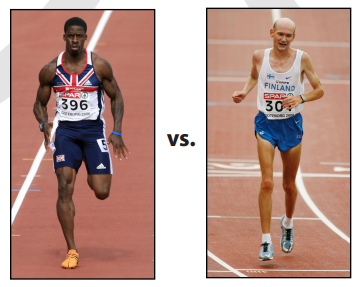In the world of mixed martial arts (MMA), where athletes strive for peak physical conditioning and performance, the role of aerobic training, particularly running, remains a topic of debate. While traditional aerobic exercises like distance running have long been considered essential for building endurance and cardiovascular fitness, some MMA practitioners question its efficacy and relevance in a sport characterized by explosive power, agility, and anaerobic bursts. This article delves into the relationship between running and MMA, exploring the potential benefits and drawbacks of incorporating aerobic training into the regimen of MMA athletes.
There’s no doubt that MMA athletes need to be absolute (primal) machines. They are required to train all energy systems (phosphagen, glycolytic/lactic and aerobic), develop high levels of endurance, strength, speed, agility, explosiveness, bone/ligament/tendon and muscle development, flexibility and technical drills. When considering the human response to running and our evolutionary history, the question arises: Are we really meant to jog at all?
The Paleolithic approach suggests that jogging for hours in a primitive environment lacks common sense. Instead, our ancestors likely evolved from either sprinting or walking long distances in search of food or shelter. However, jogging has played a crucial role in human evolution. Chasing a jogging animal was a key hunting strategy, as the animal couldn’t pant while jogging, leading to overheating and eventual exhaustion. This concept challenges traditional views but highlights the significance of jogging in our evolutionary history.
That was the conclusion of a study published in the Nov. 18 issue of the journal Nature by University of Utah biologist Dennis Bramble and Harvard University anthropologist Daniel Lieberman. Humans are poor sprinters compared with other running animals, which is partly why many scientists have dismissed running as a factor in human evolution. Human endurance running ability has been inadequately appreciated because of a failure to recognize that “high speed is not always important,” Bramble says. “What is important is combining reasonable speed with exceptional endurance.”
Anti-Jogging
Initially, most people will experience a small to moderate weight loss with aerobic exercise. However, their bodies adapt over time, becoming more efficient and burning fewer calories. So why are distance runners typically lean, and why does jogging help an MMA athlete shed weight? The answer lies in the hormonal response to aerobic exercise. Prolonged aerobic activity stimulates the production of cortisol and other stress hormones, which promote tissue breakdown. Chronic exposure to cortisol can lead to muscle loss, as well as metabolic, digestive, and hormonal issues. Fortunately, most MMA athletes incorporate jogging into their training regimen for short periods, primarily to cut weight. These issues are more prevalent among long-distance runners.

Body type adaptations in a Sprinter vs. Marathoner.
Elite endurance athletes undoubtedly have a lower body fat percentage compared to the general population, but sprinters and other anaerobic athletes typically have even lower levels. A marathoner may be considered “skinny-fat” compared to a sprinter. This is because anaerobic and strength training trigger the release of anabolic hormones, counteracting the catabolic effects of cortisol. As a result, these athletes experience less inflammation and fewer negative cortisol-related effects. So, should MMA athletes prioritize sprint training before a fight to shed weight instead?
Pro-Jogging
Humans are unique among primates in their ability to sustain running for extended periods; chimpanzees and gorillas can only run upright for a few minutes at best. While we may not be as fast as predators or prey, our endurance allows us to outlast them by jogging over long distances. Despite being physically vulnerable, humans stand out thanks to our large brains, dexterous hands, and jogging capabilities. Sweating enables efficient heat dissipation, unlike animals burdened with thick fur coats. This evolutionary advantage means humans can pursue prey until exhaustion, allowing for successful hunts despite our relatively slow pace.
Humans have evolved three remarkable adaptations that make us adept at endurance running, allowing us to rival other mammals: our upright skeletal structure, our efficient breathing, and our unique sweating ability. Our upright posture separates the movement of our legs from the expansion of our lungs, enabling us to breathe faster than we can move our legs, ensuring maximum oxygen delivery to our muscles during jogging. While animals cool themselves by seeking shade or panting, humans can simultaneously cool down and run efficiently through sweating.
The Verdict
So which train of thought is correct? Is aerobic training beneficial to stress the aerobic system, create free radicals to target gene induction, strengthen the immune system, and subsequently induce adaptations to become a fit beast? Or is it best to avoid all that oxidative stress, inflammation, and hormonal disruptions and stick to strength training and high-intensity intervals? In my opinion, completely avoiding cardio can be detrimental to overall performance and including it in your strength training schedule would serve to enhance general physical fitness or competitive preparedness for a given sport. Fitness is highly specific, and excluding any form of aerobic training will eventually reduce the size and number of mitochondria and aerobic enzymes. For instance, this could lead to MMA fighters “gassing out” when they solely focus on anaerobic high-intensity interval training and neglect other aerobic conditioning. It’s crucial to train all energy systems in MMA.
Tips for becomming a Fit-Beast
Strength Train
Correct any imbalances, work on your weaknesses, learn how to lift correctly and use smart periodisation. Done correctly, strength training will ensure an MMA athlete is developing efficient force and power-generating movement patterns.
Intermittent Sprints or Metabolic Resistance/Bodyweight Strength Circuits
Metabolic training is particularly good for fat loss whilst sparing muscle since the lactic acid accumulation stimulates insulin-like growth factors. Hard metabolic circuits can be used, for example, as 5 sets of 5min rounds with 1min rest for energy systems conditioning.
Diet
If you want to get lean, look at your diet. Eat a balanced, unprocessed, wholesome diet with enough nutrients to fuel your training and enough vitamins/minerals for health and repair. Manipulating the ratio of carbohydrates, proteins and fats to suit your individual needs and goals will also be appropriate.
To Conclude
In conclusion, the debate surrounding the role of aerobic training in mixed martial arts (MMA) remains complex. While some argue for the benefits of aerobic conditioning in enhancing overall fitness and performance, others emphasize the potential drawbacks such as oxidative stress and inflammation. However, it’s evident that a balanced approach, incorporating both aerobic and anaerobic training, is essential for optimal performance in MMA. By understanding the physiological adaptations and metabolic demands of the sport, athletes can tailor their training regimens to achieve peak physical conditioning while minimizing the risk of fatigue and injury during competition. Ultimately, a holistic approach that integrates various training modalities will best prepare MMA athletes to excel in the ring or octagon.
For a balanced yet scientific approach to training, check out my online strength and conditioning coaching.
